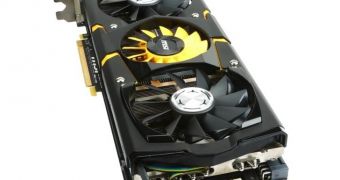Micro-Star International has finally made the official introduction of a graphics adapter which has been on our radar for a few good weeks, with the latest update on it having been made just six days ago.
We are, of course, referring to the GeForce GTX 780 Lightning, the video controller that, like all other GTX 780 cards, regardless of factory overclocking (or lack thereof), stands just one level below the GeForce GTX Titan.
Normally, the GeForce GTX 780 runs the GK110 graphics processing unit (GPU) at 863 MHz, unless the GPU Boost technology kicks in.
In that case, the clock speed jumps to 902 MHz. Not that large a leap, but still better than nothing.
Obviously, MSI wasn't about to name a card “Lightning” without making it better than the original.
Thus, is was that the product ended up with a core base speed of 980 MHz and a GPU Boost maximum setting of 1033 MHz. Clearly, those numbers are in a different league.
To ensure stability even at those settings, MSI gave the GTX 780 Lightning a 16+3 phase VRM, an additional GPU Reactor module (filters out electrical noise), high-grade chokes, PowIRstage driver-MOSFETs, and DirectFETs from International Rectifier, plus tantalum capacitors.
That way, all that power brought through the two 8-pin PCI Express connectors is put to good use, instead of being wasted or overwhelming the circuitry.
All the while, the 3 GB of GDDR5 VRAM work at 6 GHz over the 384-bit interface. Here, at least, there was no tweaking involved.
As for the cooler, the TriFrozr merges the benefits of a large aluminum fin stack with those of several 8 mm heatpipes and three fans (each with its own 4-pin PCB connection). MSI's Afterburner utility is enough to individually control the rotary speeds of each fan.
MSI's GeForce GTX 780 Lightning bears a price of $749.99 / €749.99. That's $100 / €100 more than the reference tag.

 14 DAY TRIAL //
14 DAY TRIAL //